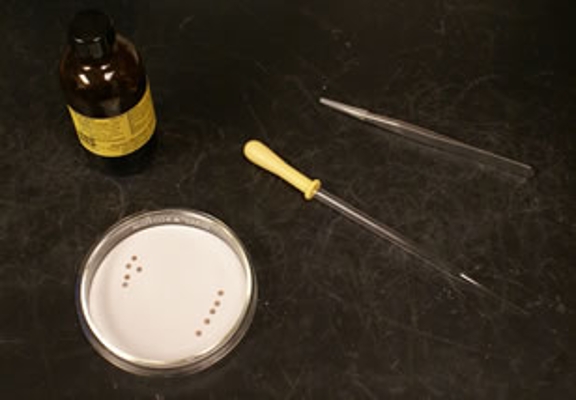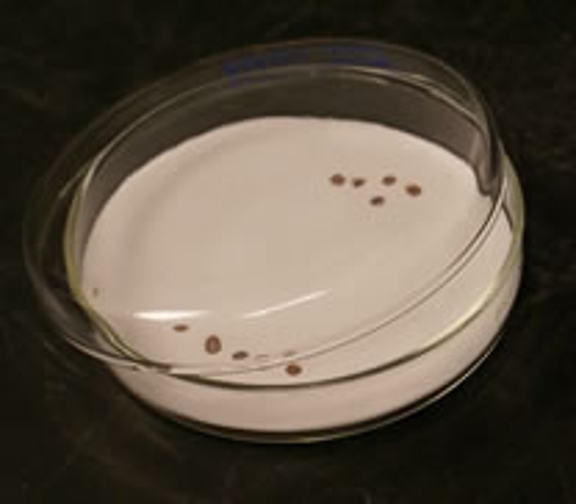To obtain information contained in document files on this page in an accessible format please contact the Electron Microscopy Center at (812) 856-1457 or through email at dagmorga@indiana.edu
Removing Plastic from EM Grids
Several methods are available for removing the plastic backing from purchased or home-made EM grids that have a carbon layer on top of a plastic (usually Formvar) layer. Some of these methods can also be used to remove residual plastic from Quantifoil holey carbon films.
Several of the methods that follow involve organic solvents and should be performed in a fume hood with the usual safety precautions. Also note that when removing carbon-coated plastic layers from grids such as Ted Pella type-A Carbon support films with a removable Formvar backing, extensive soaking in organic solvents is not recommended.
NOTE: Many people do not automatically pre-treat Quantifoil grids to remove residual plastic (though some do) and as a general rule, the less Quantifoil (and C-Flat) grids are handled, the better. However, residual plastic on Quantifoil grids will affect the reproducibility of freezing and the material should be removed if present.
Solvent treatments



- Chloroform is a good solvent for removing plastics, and an easy and gentle way to do this is to put three or four filter paper disks into a (glass) Petri dish, soak the filter paper with chloroform (1 to 1.5 ml) and place the grids (carbon/plastic side up) onto the filter paper. Put the top on the Petri dish and leave the grids in this chloroform-rich atmosphere for at least 30 minutes (overnight is good). slightly opened Petri dish to allow solvent to evaporate
- Bob Grassucci recommends doing this for at least 4 hr to remove residual plastic from Quantifoil grids. Teresa Ruiz says to end this process by slightly raising the Petri dish lid (allowing the chloroform vapors to escape but preventing material in the air from falling onto the grids) and allowing the chloroform to evaporate over the next 30 minutes or so. The Petri dish will chill as the chloroform evaporates, and when the bottom of the Petri dish has returned to room temperature, the evaporation is complete. glass scintillation vial with soaking grids
- A stronger (but potentially more damaging) treatment is to soak the grids in solvents such as chloroform, acetone or ethyl acetate. Some people soak for as little as 10 seconds (really just passing a grid into and out of the bulk solvent) and others soak for as long as overnight - more information can be found in Ted Pella's technical notes on removing plastic. A glass scintillation vial is useful for long soaks since screwing the cap tightly will prevent evaporation. When such soaking is done for lots of grids, be certain that the grids do not stack on top of one another. Also, remember that agitation can break the carbon film, so treat the grids gently during all these manipulations.
- Another wrinkle on the soaking method (from Teresa Ruiz) is to clasp a grid with self-closing tweezers, submerge it in chloroform and gently rock the grid back and forth (so that the solvent effectively flows along the grid surface, instead of pushing against it) for about 30 s. Remove the grid from the chloroform, wait 10 to 15 s (to allow all the chloroform to evaporate), transfer the grid to (EM grade) 100% ethanol and repeat the rocking procedure for ~30 s. Finally, remove the grid from the ethanol and allow it to air dry before attempting to release it from the tweezers.
Thin Layer Chromotography (TLC)
This method is an elaboration on the solvent methods described above that was used by people in Wah Chiu's lab when he was in Arizona, and is another very gentle method to remove plastic layers from purchased or home-made grids. The method makes use of ideas behind paper chromatography to gently remove the plastic layer from various EM grids.
- If a small chromatography tank is not available, find a glass vessel that can be sealed to prevent solvent evaporation.
- Cut a sheet of chromatography paper (Whatman #1 works well) that can stand inside the glass tank with the top end leaning against one wall. The paper needs to stand enough off-vertical that grids placed on it do not fall off when the paper is placed in the chamber.
- Place a row of grids about 2 cm from the edge of the paper that will become the "bottom" edge when it is in the tank.
- Put the paper into the glass tank and add roughly 1 cm of chloroform to the bottom of the tank. You may or may not find it easier to add the chloroform before standing the paper in the tank.
- Seal the tank shut and allow the solvent to migrate past the grids to the top of the paper. Factors such as the type of paper and the ambient temperature will control how long this takes.
- Either remove the paper (and grids) from the vessel, or remove the bulk chloroform from the vessel, and allow the paper to dry.
- Repeat steps 4 thru 6 two or three times.
How It Works
As the solvent front moves up the chromatography paper, there is a slow, continuous flow of fresh chloroform past the row of grids that gently strips away the plastic layer without putting undue stress on the carbon film.
Glow Discharging
If you have access to an Ar/O (or Ar/O/H) plasma cleaner, brief treatment will both remove residual plastic from Quantifoil grids and leave the carbon film hydrophilic. You will need to experiment with your particular system to determine the optimal conditions, keeping in mind that not only can the plasma burn off the residual plastic, but it can also totally incinerate the carbon film!
We would like to thank all the people who responded to a question about such treatments that was posted to the 3DEM Mailing List. Details provided by Bob Grassucci and Teresa Ruiz were especially helpful.

